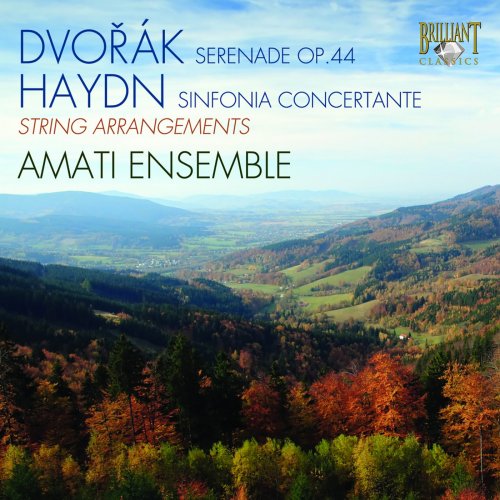
Amati-Ensemble, Gil Sharon - Dvořák & Haydn: String Arrangements (2009)
BAND/ARTIST: Amati-Ensemble, Gil Sharon
- Title: Dvořák & Haydn: String Arrangements
- Year Of Release: 2009
- Label: Brilliant Classics
- Genre: Classical
- Quality: flac lossless (tracks) +Booklet
- Total Time: 00:47:11
- Total Size: 197 mb
- WebSite: Album Preview
Tracklist
01. Serenade in D Minor, Op. 44: I. Moderato, quasi marcia (Arr. by Mordechai Rechtman)
02. Serenade in D Minor, Op. 44: II. Minuetto (Arr. by Mordechai Rechtman)
03. Serenade in D Minor, Op. 44: III. Andante con moto (Arr. by Mordechai Rechtman)
04. Serenade in D Minor, Op. 44: IV. Finale. Allegro molto (Arr. by Mordechai Rechtman)
05. Sinfonia concertante, Hob. I:105: I. Allegro (Arr. by Mordechai Rechtman)
06. Sinfonia concertante, Hob. I:105: II. Andante (Arr. by Mordechai Rechtman)
07. Sinfonia concertante, Hob. I:105: III. Finale. Allegro con spirituo (Arr. by Mordechai Rechtman)
The art of arranging music so that the works can be played in a small venue or domestic environment is as old as time. Before the advent of mechanical music reproduction around the time of World War I, the parlour piano and reductions of orchestral and operatic scores for small ensemble were the only ways a wider public could enjoy such music in the home.
On thisrelease, two popular works are given similar treatment in skilful arrangements by Mordechai Rechtman. Dvorák’s serenade for wind ensemble dates from 1878, and is a genial work of grace and charm written for a group of friends. Dvorak admired the wind serenades of Mozart, and coupled with the earthiness of Czech rhythms and folk dances, the serenade has become one of Dvorák’s most popular and engaging works.
Haydn’s Symphonia Concertante is a late work written in the 1790s. It is one of the last examples of a genre that is directly descended from the Baroque concerto grosso – Beethoven’s Triple Concerto being probably the final example. Typically, it is wonderfully fresh energetic music of undimmed inventiveness and humour, and belies the fact that Haydn was now an old man.
01. Serenade in D Minor, Op. 44: I. Moderato, quasi marcia (Arr. by Mordechai Rechtman)
02. Serenade in D Minor, Op. 44: II. Minuetto (Arr. by Mordechai Rechtman)
03. Serenade in D Minor, Op. 44: III. Andante con moto (Arr. by Mordechai Rechtman)
04. Serenade in D Minor, Op. 44: IV. Finale. Allegro molto (Arr. by Mordechai Rechtman)
05. Sinfonia concertante, Hob. I:105: I. Allegro (Arr. by Mordechai Rechtman)
06. Sinfonia concertante, Hob. I:105: II. Andante (Arr. by Mordechai Rechtman)
07. Sinfonia concertante, Hob. I:105: III. Finale. Allegro con spirituo (Arr. by Mordechai Rechtman)
The art of arranging music so that the works can be played in a small venue or domestic environment is as old as time. Before the advent of mechanical music reproduction around the time of World War I, the parlour piano and reductions of orchestral and operatic scores for small ensemble were the only ways a wider public could enjoy such music in the home.
On thisrelease, two popular works are given similar treatment in skilful arrangements by Mordechai Rechtman. Dvorák’s serenade for wind ensemble dates from 1878, and is a genial work of grace and charm written for a group of friends. Dvorak admired the wind serenades of Mozart, and coupled with the earthiness of Czech rhythms and folk dances, the serenade has become one of Dvorák’s most popular and engaging works.
Haydn’s Symphonia Concertante is a late work written in the 1790s. It is one of the last examples of a genre that is directly descended from the Baroque concerto grosso – Beethoven’s Triple Concerto being probably the final example. Typically, it is wonderfully fresh energetic music of undimmed inventiveness and humour, and belies the fact that Haydn was now an old man.
As a ISRA.CLOUD's PREMIUM member you will have the following benefits:
- Unlimited high speed downloads
- Download directly without waiting time
- Unlimited parallel downloads
- Support for download accelerators
- No advertising
- Resume broken downloads


